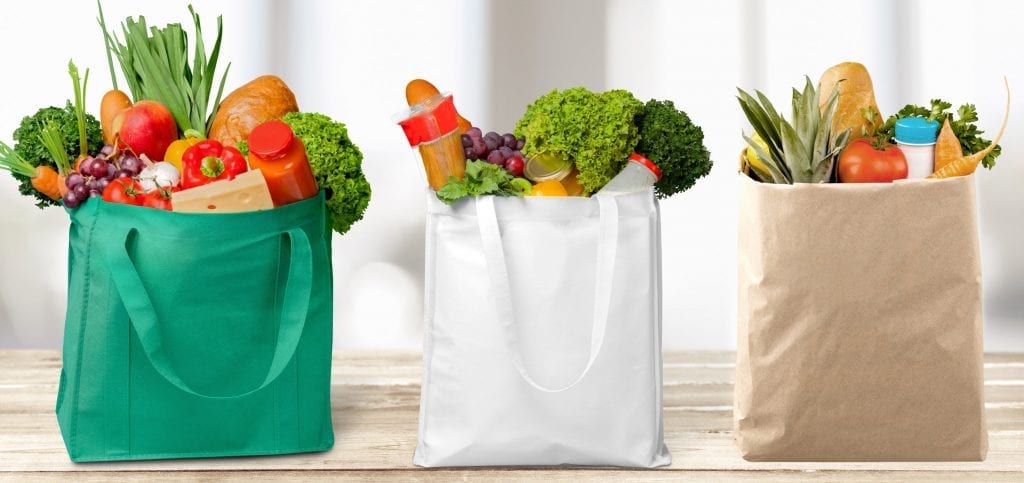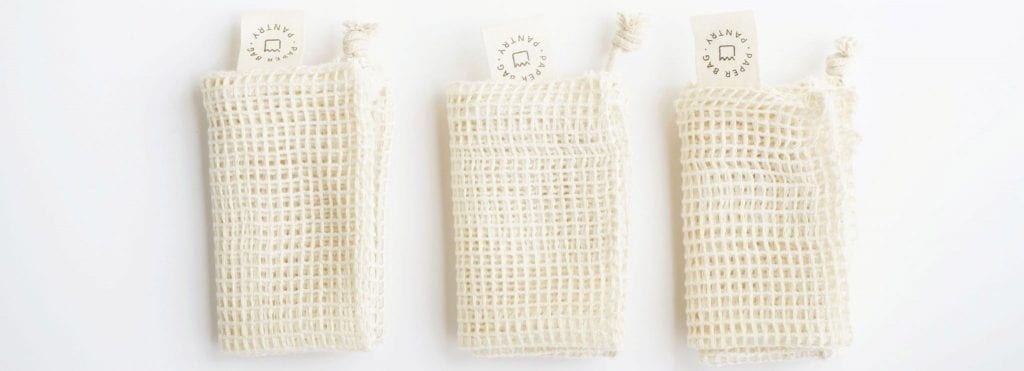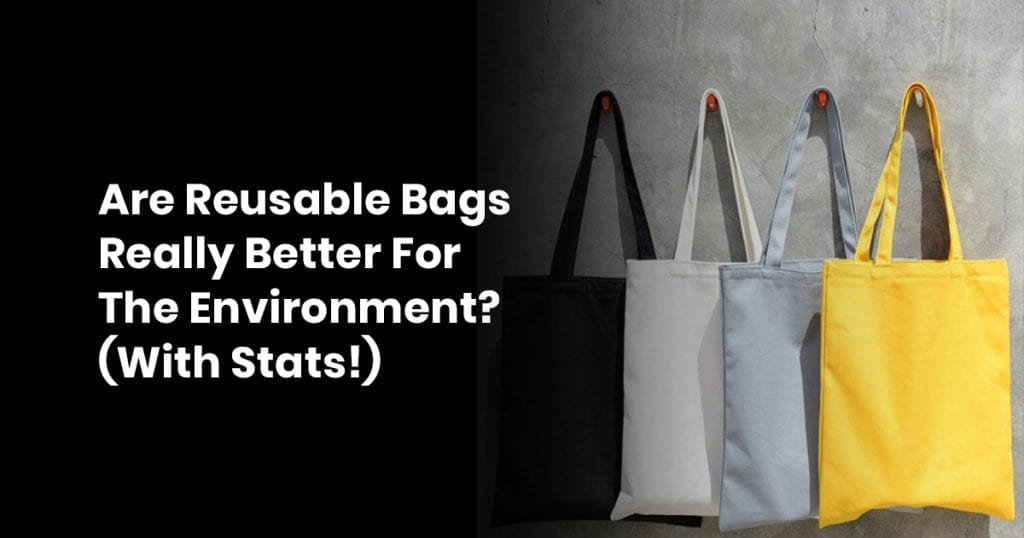Everyone is told to utilize reusable bags, but does anyone really know much about them?
We do. There’s misinformation, and frankly just not enough information out there about reusable grocery bags, so we’re here to set the record straight.
So, are reusable bags really better for the environment?
The short answer is yes, but there are other factors to consider, including manufacturing costs, product lifespan, and time spent in actual use.
Let’s discuss how you can actually measure that, though, because every manufacture has different practices when it comes to actually producing plastic bags.
Spoiler alert: none of them are good.
Manufacturers create plastic bags, and then distribute them to distribution centers for major brands and companies (think Walmart and Giant Foods for example).
From there, they’re then distributed through an internal program to stores, and picked up by the consumers upon exiting with their groceries.
Contents
Why Are Plastic Bags Bad?
So let’s dissect them so we can first understand how bad plastic bags are for the environment, then discuss the excellent benefits of switching to reusable items like multi-use bags.
One trillion plastic bags are created every year.
That’s a global figure.
With that statistic, it means that over two million bags are made every single minute.
A lot of fuel has to go into producing these bags, which adds more to the environmental damage we’re causing.
Then it costs fuel to distribute those bags.
It’s not possible to know the distance between every distribution center in America, nor the exact mileage of the trucks driving them, but if we assume one-hundred miles of distance and twenty miles to the gallon, that’s five gallons of gas just to move those plastic bags.
The amount of energy that it takes to make 12 bags is the equivalent of powering a vehicle for a mile, so another 60 plastic bags worth of energy are wasted just to move them from place to place.
Plastic bags bleed polypropylene and BPAs into the soil, which in turn ruins the soil, and then washes into streams, rivers, and other bodies of water that lead to the ocean. It all comes back to the ocean.
Okay, so we’re caught up on just how bad these are for the environment. But what if we all switched to reusable shopping bags instead?
There’s still manufacturing and distribution costs, but in an ideal world, we would eventually require far less reusable bags to be created than their plastic counterparts.
Reusable bags have a very long lifespan, especially if you take care of them properly, which is why they’re such an excellent option.
On top of that, reusable bags can be retired for other purposes once they’re tattered and no longer viable for groceries.
Provided that you use them enough, reusable bags are better for the environment, just not at first.
If you purchase reusable bags—which cost more energy to produce than the equivalent number of plastic bags—you need to actually use them frequently, and for a long period of time for them to be worthwhile.
So reusable bags technically cost more to manufacture when they’re in the factory (if you’re comparing them to the cost of producing a single plastic shopping bag), but don’t cost as much to gather materials for.
Most reusable bags have a cotton blend construction, and cotton farming costs less than mining and gathering oils that are used in plastic.
Cotton is also biodegradable, so even if you don’t get as many uses as you’d like out of it, at least it won’t hang around for a millennium.
Everyone would like to believe that just buying reusable bags is the answer, but there’s a little more than goes into it than that.
Let’s talk about how many times you actually need to remember to bring your cloth grocery bags along before you make a positive environmental impact.
How Many Times do I Need to Use a Reusable Bag for it to Matter?

About 56 times.
The average cotton shopping bag weighs about 1.6 ounces when empty, and a plastic shopping bag weighs about 5.5 grams (the thin and transparent polypropylene kind).
If you use a cotton bag 46 times, you’re justifying the weight of the material versus the weight of plastic that would have been used.
That’s basically what you need to break even.
Manufacturing one cotton bag is more energy-efficient than manufacturing 46 plastic bags, and that’s great for air pollution, but the end goal is to prevent those 46 pieces of plastic from entering landfills and our oceans.
There are over five trillion pieces of plastic currently littering the ocean, and a hefty percentage of those are plastic bags.
As defined by a Danish study in 2018, any cotton grocery bag should be used 7,100 times for it to truly be positive for the environment.
When the United States researched a similar point, they defined a much lower number for the full lifetime of a cotton grocery bag.
Why? Because American consumers are apparently more likely to forget their reusable bags, and end up using plastics anyway, which negates the point in buying reusable bags in the first place.
That means that instead of taking yourself out of the plastic bag pollution equation, those people are occasionally dipping their toes back in the water for short bursts of time and using plastic anyway.
46 uses to break even, and as many uses as you can possible get out of the bags afterwards—that’s how you make reusable bag purchases worth your time.
Are Reusable Bags Better Than Plastic?

Yes: they’re better for the environment, and could actually bring down the supply and demand of single-use plastic bags in the future.
Plastic bags can take a millennium to degrade in nature, at which point it will have poised the soil and nearby water sources, but reusable bags don’t.
Well, most of them don’t. Some reusable bags are made out of PVC, which is one of the most toxic forms of plastic that there is.
The mindset many people have is, “Well, I’m not going to throw it out, so it doesn’t matter,” but nothing could be farther from the truth.
Reusable bags are meant to have an end to their life cycle. Purchasing them with the intent of never throwing them out is unreasonable.
The handles will eventually undergo enough stress and break, holes might form, there’s just a lot of things that could go wrong.
If you are going to throw out a reusable bag (after years of continuous use), then it makes sense for it to be biodegradable. The biodegradable definition stats the product will breakdown after an allotted time, which is great!
So most reusable bags are better than plastic bags.
There’s an upfront environmental cost of manufacturing and distribution, but after that point you decide how much of an impact will be made on the environment.
If you can use a few bags for your weekly grocery shopping, and care for them enough to last for five years, you’ll be able to stop over 2,000 plastic bags, or 24.2 pounds of plastic out of the landfills and oceans.
Why is Cotton a Great Material for Grocery Bags?

Cotton is less expensive to produce, and less costly on the environment during manufacturing.
The best part about cotton is that it is biodegradable, so when you eventually wear through your reusable bags you’ll be able to throw them out without making a black mark on the earth.
Cotton comes from nature, and breaks down within a year or two after it’s been reintroduced to the earth, making it fully biodegradable.
If the cotton bags in question don’t contain harsh or chemical dyes (there are excellent natural dyes that don’t harm the earth), then microorganisms will have absolutely no trouble breaking down the cotton.
When you compare those facts to plastic, it’s a no-brainer.
Plastic can take a millennium to break down, or at the very least, around 450 years for thin plastic bottles.
Plastic actually shares one fact with cotton: they’re both made of polymers, but two different types.
Synthetic polymers, which are in plastic, are laboratory-made and cannot be found in nature.
Their simple, though powerful molecular composition makes them extremely difficult to break down through natural means.
Microorganisms have little to no effect on synthetic polymers. The only thing that can break them down is UV light from the sun, and that’s provided that discarded plastic actually has direct sunlight to degrade in.
Then you have naturally occuring polymers, which are found in cotton, wool, and leather. These still have a similar molecular structure, but are biodegradable.
You can have a cotton or canvas backpack for thirty years and have it look like new, or a leather jacket for a century and still retain that bit of luster.
The difference is that when they are introduced to natural microorganisms found in soil and nature, they will break down without harming any part of nature. In short, cotton breaks down quickly without leaving negative effects on the earth.

